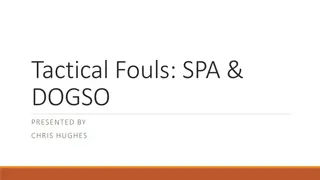Lacrosse Fouls and Penalties: A Comprehensive Guide
This guide provides detailed explanations of various lacrosse fouls and penalties, including personal fouls, cross-checking, illegal body checks, slashing, tripping, unnecessary roughness, and unsportsmanlike conduct. Each section describes the specific actions that constitute a foul, the penalties associated with each offense, and important considerations for referees and players. With clear examples and images, this resource is essential for understanding the rules and regulations of lacrosse.
Uploaded on Sep 14, 2024 | 0 Views
Download Presentation

Please find below an Image/Link to download the presentation.
The content on the website is provided AS IS for your information and personal use only. It may not be sold, licensed, or shared on other websites without obtaining consent from the author.If you encounter any issues during the download, it is possible that the publisher has removed the file from their server.
You are allowed to download the files provided on this website for personal or commercial use, subject to the condition that they are used lawfully. All files are the property of their respective owners.
The content on the website is provided AS IS for your information and personal use only. It may not be sold, licensed, or shared on other websites without obtaining consent from the author.
E N D
Presentation Transcript
Personal & Technical Fouls Rick Catalano NILOA, EMLOA official, MBYLL Metro West Referee Coordinator
What is a personal foul? Personal fouls are those fouls of a serious nature. The penalty for a personal foul shall be a time serving penalty. Penalties shall be either one, two or three minutes depending on severity and intent of the foul.
Cross Check A player may not check an opponent with the crosse. Handle will be exposed between the hands and player will utilize a punching or thrusting motion to deliver check. Look for broken sticks!
Illegal Body Check A check above the shoulders or below the waist is illegal. A check from behind is illegal. A check delivered to a player while he is laying or kneeling down is illegal. Spearing leading with the top of the helmet is at a minimum a one-minute, non- releasable foul.
Illegal Body Check (cont.) If a player turns his back to, jumps or ducks as a check is coming in an attempt to draw illegal contact, no foul has been committed.
Slashing Swinging a crosse at an opponent s crosse or body with viciousness or reckless abandon, regardless of whether the opponent s crosse or body is struck. Striking an opponent on any part of the body in an attempt to dislodge the ball. Checks must be stick on stick. If player is shooting, passing or scooping ball, no slash occurs unless unnatural follow-through. MBYLL: No one-handed checks!
Tripping May not trip opposing player with any part of body or crosse. Can sell as a push when player makes contact with player from behind.
Unnecessary Roughness Excessive in nature. Running through screen/pick. Late hit (illegal body check). Good to use when players are pushing and shoving each other before fight breaks out. Defenseless players MBYLL: mandatory locked-in penalty, 2-3 min.
Unsportsmanlike Conduct Arguing with official. Profanity (especially F-Bombs). Calling undue attention to oneself. Hiding player in special substitution area. First three are non-releasable fouls.
Illegal Crosse/Equipment Deep pocket one minute non-releasable. Stick can return to game if fixed. Stick must be between 40-42 inches long and 6 inches at widest point of head (inside measurement). Penalty is three minutes, non-releasable and stick is removed from game and placed on table. Illegal gloves or shoulder pads are one-minute, non- releasable fouls. Be proactive before game to notice equipment violations!
What is a technical foul? Technical fouls are those of a less serious nature than personal fouls. Include all violations of the rules of lacrosse except those specifically listed under personal fouls. Time serving, 30 second penalty if ball was in possession of team that was offended. Turnover if team with possession commits technical foul. Award possession to offended team if ball was loose at time of foul (Play-on situation).
Crease Violation Goalkeeper Interference Interfering with goalie while defensive team possesses ball outside of crease (flag down, slow whistle). Attack runs through crease while defensive team possesses ball outside of crease (flag down, slow whistle). Interference with goalie while ball is in crease. Possession play on ball awarded at midfield if pass not completed No possession play on ball awarded 20 yards lateral if no possession gained.
Holding A player may not hold an opponent with his crosse. A player may not step on the crosse of opponent. A player may not hold with the free hand. A player man not hold with the shaft of his stick and hands apart (cross-check hold) Reminders: Equal pressure from rear is not a hold. Crosse against crosse is not a hold unless player is pinning crosse of his opponent against his opponent s body. Both hands must remain on stick when checking.
Illegal Offensive Screen Player must be stationary when setting picks. Stick should be straight up and down and within his body. No leaning or stepping into player.
Conduct Foul Coach/player entering field without permission or reason to do so. Use of artificial aids (electronic devices, megaphones) to communicate with players. Argue with officials. Swearing Taunting other players.
Interference Interfering with the free movement of an opponent except when that opponent has the ball, or both players are within 5 yards (3 for most youth) of a loose ball or a ball in flight. Occurs on loose balls when one player scoops ball and other player still engages opponent Also occurs in front of crease in settled situations.
Offsides No more than 6 players in a team s offensive end or 7 in its defensive end, including players in the penalty area Team in possession is offsides: Turnover. Team without possession offsides: Flag down, slow whistle. B1 goes offsides and returns to proper half of field, then goes offsides again. RULING Same player going offsides twice is only one technical foul.
Pushing Player will not shove or thrust opponent from rear. Not a violent blow. Permitted from front or side as long as within 5 yards of loose ball (3 yards in youth) or opponent has possession. Both hands must be on crosse.
Stalling Team is ahead with under 2 minutes in game. Team is obviously keeping ball from play. Only occurs in offensive attack box. Violation is called when ball exits attack area or player steps out of attack area with ball. Either team is entitled to retrieve ball if pass is deflected off defensive stick and ball exits attack area. Offensive team regains possession they have 10 seconds to get it back in and stalling warning continues.
Warding Off A player may not use his free hand, arm or any part of his body to gain advantage, push or control the direction of the movement of the crosse or body of the player applying the check. A player may protect his crosse with his free hand provided he does not attempt to engage the crosse with his free hand.
Withholding Ball From Play When a loose ball is on the ground, a player may not lie on the ball or trap it with his crosse longer than is necessary to pick it up.
Illegal Procedure Section 6-5 (Page 39-40 of NFHS) covers most technical fouls
Remaining subjects Failure to advance 20 seconds from defensive zone to zone 3 and 10 seconds from zone 3 to zone 4. Substitution violation players entering field early. Delay of game after goal scored or upon turnover, rolling/throwing ball away (falls under illegal procedure).























